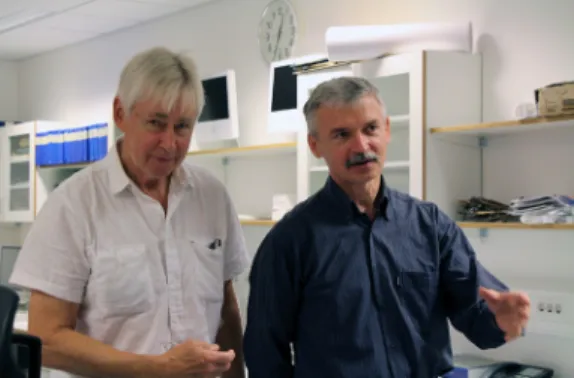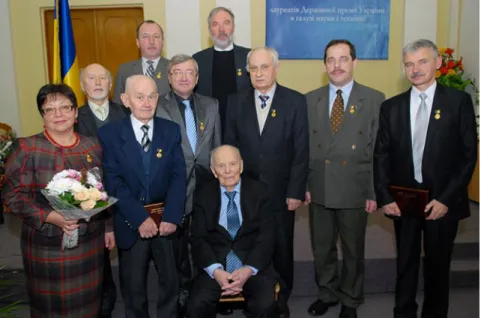© 2019 Akadémiai Kiadó, Budapest
Acta Botanica Hungarica 61(1–2), pp. 1–4, 2019 DOI: 10.1556/034.61.2019.1-2.1
SERGIJ Y. KONDRATYUK – A 60TH BIRTHDAY TRIBUTE
I. Kärnefelt1, L. Lőkös2, M. R. D. Seaward3, A. Thell1* and N. Thell4
1Biological Museum, Lund University, Box 117, 22100 Lund, Sweden E-mails: ingvar.karnefelt@biol.lu.se, *arne.thell@biol.lu.se
2Department of Botany, Hungarian Natural History Museum H-1431 Budapest, Pf. 137, Hungary; E-mail: lokos.laszlo@nhmus.hu
3School of Archaeological & Forensic Sciences, University of Bradford, Bradford BD7 1DP, UK E-mail: m.r.d.seaward@bradford.ac.uk
4School of Social Work, Lund University, Box 117, 22100 Lund, Sweden E-mail: nataliya.thell@soch.lu.se
On 17 May 2019 the Ukrainian lichenologist Sergij (Sergey) Kondrat yuk celebrates his 60th birthday. Sergij was born in the former Ukrainian Soviet Socialistic Republic (now Ukraine) in the town Ulianivka (now Blagovish
chenske). He was the second child, after his sister Vira, of Yakiv and Anna Kondratyuk (born as Rusavska). Sergij’s middle, patronymic, name is Yako
vich from his father’s name Yakiv.
Sergij’s interest in biology was triggered by his grandfather Ivan Ru
savsky who luckily escaped execution by Nazi Germans in World War II and worked afterwards as a gardener on a collective farm and as deacon in a local church. As a man of great kindness and wisdom, he was the first mentor of Sergij, who much later in life honoured him with the generic name Rusavs- kia for the Xanthoria elegans group (Hertel 2012). Already at secondary school Sergij showed deep interest and distinguished skills in biology, several times participating in biology competitions (Olympiads) at the highest level be
tween representatives from different Soviet republics, and winning first and third prizes on different occasions. After school, he moved to Kiev to study at the Biological Faculty of the Taras Shevchenko National University, from where he graduated in 1981 with a diploma work entitled ‘Lichens of Kaniv State Nature Reserve’ supervised by Nadiya Massjuk in the Department of Lower Plants. Nadiya Massjuk and later Oleg Blum both inspired Sergij to choose lichenology as his specialisation.
In 1981 Sergij was enrolled as a postgraduate student in the Department of Algology and Lichenology at the M. H. Kholodny Institute of Botany in Kiev, a research institute within the National Academy of Science of Ukraine, to which he has been affiliated ever since. In line with the twodoctorallevel system, characteristic of the former Soviet Union and some postSoviet coun
tries, including Ukraine, Sergij defended two doctoral dissertations. He earned the degrees of Candidate of Science (equivalent to a PhD) in 1985 for the thesis entitled ‘Lichens of Priednieper Height’ supervised by Oleg Blum, and Doctor
Acta Bot. Hung. 61, 2019
2 KÄRNEFELT, I., LŐKÖS, L., SEAWARD, M. R. D., THELL, A. and THELL, N.
of Science (comparable to Habilitation) in 1996 for the thesis ‘Lichen flora of Ukrainian Plains and its analysis’. Since then he has supervised twelve and three theses, respectively, for Candidate of Science and Doctor of Science, in
cluding three INTAS1 PhD studentships and one Alexander von Humboldt Fellowship; his postgraduate students include Lyudmyla Dymytrova, Na
taliya Fedorenko, Olga Nadyeina and Oleksii Redchenko (e.g. Fedorenko et al. 2012). Since 2006, Sergij has the academic title of Professor.
Sergij’s international career began in 1993 with a onemonth stay hosted by the legendary Josef Poelt (1924–1995) at the Institute of Botany in Graz, Austria (Kondratyuk and Poelt 1997). Shortly afterwards, in 1993–1994, he visited David Galloway at the Natural History Museum in London, where he studied lichenicolous fungi associated with Lobariaceae and Stictaceae, the taxonomy of which was revised with David Hawksworth and Brian Coppins (e.g. Coppins and Kondratyuk 1995).
In 1995–2009 Sergij frequently visited the Botanical Museum of Lund Uni
versity where he had a highly productive partnership with Ingvar Kärnefelt (Figs 1–2). Together they studied the large lichen family Teloschistaceae on a worldwide basis, using their collections from several field trips, including those from Australia in 2003 and 2004, as well as extensive herbarium material.
Ingvar and Sergij, occasionally with col
leagues, described more than 60 species within the family Teloschistaceae distrib
1International Association for the promotion of cooperation with scientists from the New Independent States of the former Soviet Union.
Fig. 1. Sergij Kondratyuk outside the Botanical Museum in Lund in 2008 during one of his many visits as guest
researcher there
Fig. 2. Ingvar Kärnefelt and Sergij Kondratyuk in 2014. They started a successful cooperation in
the early 1990s, which is still ongoing
Acta Bot. Hung. 61, 2019
3
SERGIJ Y. KONDRATYUK – A 60TH BIRTHDAY TRIBUTE
uted mainly in the Southern Hemisphere (e.g. Kärnefelt and Kondratyuk 2004, Kondratyuk and Kärnefelt 1997, Kondratyuk et al. 2009).
After Ingvar’s retirement in 2011, Sergij cooperated with prof. JaeSeoun Hur at the Korean Lichen Research Institute (KoLRI), Sunchon National Uni
versity, the Republic of Korea. There Sergij often worked together with his close friend, the Hungarian lichenologist László Lőkös, as they recorded the lichen flora of South Korea. They described a large number of new genera and species in the Lecanoraceae, Physciaceae and Ramalinaceae and more than 100 species new to science. The results were mainly published as a series entitled ‘New and noteworthy lichenforming and lichenicolous fungi I–VIII’ in Acta Botanica Hun- garica in 2013–2019. During his collaboration with the Korean Lichen Research Institute, a new taxonomy for the Teloschistaceae, including more than 40 new genera and 50 new species, was determined, based often on threegene phy
logenies (Kondratyuk et al. 2013, 2014). Sergij is a strong advocate for a narrow genus concept and therefore his taxonomy is not accepted by all lichenologists.
To date, Sergij has written more than 400 scientific publications (including 25 monographs), half of which are in English; his work follows an early tradition of naming plants after colleagues and friends, such as Josefpoeltia, Gallowayella, Kaernefia, Jackelixia, Jasonhuria, Loekoesia, Gintarasiella, Massjukiella, Olegblumia,
Fig. 3. Sergij Kondratyuk receives the State Award of Ukraine in the field of science and technology from the President of National Academy of Sciences of Ukraine, Academician B. Ye. Paton (sitting in the centre), in 2014. The first row from left to right: G. G. Minicheva, Y. P. Didukh, Y. P. Zaytsev, B. G. Alexandrov, O. B. Blum, I. F. Buksha, S. Y. Kondratyuk.
The second row: Y. G. Tyutyunnyk, S. A. Afanasyev
Acta Bot. Hung. 61, 2019
4 KÄRNEFELT, I., LŐKÖS, L., SEAWARD, M. R. D., THELL, A. and THELL, N.
Coppinsiella and Seawardiella, as well as other names proposed for monophyletic clades in the Teloschistaceae and other families of the Lecanorales.
For his distinguished work, Sergij has received several important awards, such as the M. H. Kholodny Award of National Academy of Sciences (NAS) of Ukraine in 2013, the highest prize in the field of biological sciences in the country, as well as the State Award in the field of science and technology in 2014 (Fig. 3). Interestingly, the latter was granted not for studying taxonomy, but for elaborating methods of bioindication and monitoring of the environ
ment of Ukraine. He received this prize as a member of a research group, which included Oleg Blum. Sergij mapped air pollution in cities and areas in the vicinity of large industries, as well as studied lichens as indicators of old
growth forests. Since 2018 Sergij has been a member of the Scientific Council of the National Research Foundation of Ukraine.
Sergij is widely recognised for his enormous knowledge and output, and is greatly appreciated among colleagues, friends and relatives. We wish him all the best for his birthday and many more years as a dedicated lichenologist.
REFERENCES
Coppins, B. and Kondratyuk, S. Y. (1995): Stygiomyces and Pseudonitschkia: two new gen
era of lichenicolous fungi. – Edinburgh J. Bot. 52(2): 229–236. https://doi.org/10.1017 /s0960428600000998
Fedorenko, N. M., Stenroos, S., Thell, A., Kärnefelt, I., Elix, J. A., Hur, J.S. and Kondratyuk, S. Y. (2012): Molecular phylogeny of xanthorioid lichens (Teloschistaceae, Ascomy
cota), with notes on their morphology. – Bibl. Lichenol. 108: 45–64.
Hertel, H. (2012): Gattungseponyme bei Flechten und lichenicolen Pilzen. – Bibl. Lichenol.
107: 1–157.
Kärnefelt, I. and Kondratyuk, S. Y. (2004): Contributions to the lichen genus Caloplaca (Teloschistaceae) from Australia. – Bibl. Lichenol. 88: 255–265.
Kondratyuk, S. Y. and Kärnefelt, I. (1997): Josefpoeltia and Xanthomendoza, two new gen
era in the Teloschistaceae (lichenized Ascomycotina). – Bibl. Lichenol. 68: 19–44.
Kondratyuk, S. and Poelt, J. (1997): Two new Asian Xanthoria species (Teloschistace
ae, lichenized Ascomycotina). – Lichenologist 29: 173–190. https://doi.org/10.1017 /s0024282997000200
Kondratyuk, S. Y., Kärnefelt, I., Elix, J. A. and Thell, A. (2009): Contributions to the Tel
oschistaceae, with particular reference to the Southern Hemisphere. – Bibl. Lichenol.
100: 207–282.
Kondratyuk, S. Y., Lőkös, L., Tschabanenko, S., Haji-Moniri, M., Farkas, E., Wang, X. Y., Oh, S.O. and Hur, J.S. (2013): New and noteworthy lichenforming and lichenicolous fungi. – Acta Bot. Hung. 55(3–4): 275–349. https://doi.org/10.1556/abot.55.2013.34.9 Kondratyuk, S. Y., Kärnefelt, I., Thell, A., Elix, J. A., Kim, J., Jeong, M.H., Yu, N.N., Kon
dratiuk, A. and Hur, J.S. (2014): A revised taxonomy for the subfamily Xanthorioide
ae (Teloschistaceae, Ascomycota) based on molecular phylogeny. – Acta Bot. Hung.
56(1–2): 141–178. https://doi.org/10.1556/ABot.56.2014.12.12

